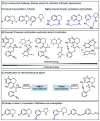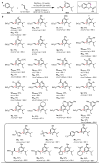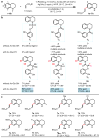Conformation-induced remote meta-C-H activation of amines
- PMID: 24622200
- PMCID: PMC3980735
- DOI: 10.1038/nature12963
Conformation-induced remote meta-C-H activation of amines
Abstract
Achieving site selectivity in carbon-hydrogen (C-H) functionalization reactions is a long-standing challenge in organic chemistry. The small differences in intrinsic reactivity of C-H bonds in any given organic molecule can lead to the activation of undesired C-H bonds by a non-selective catalyst. One solution to this problem is to distinguish C-H bonds on the basis of their location in the molecule relative to a specific functional group. In this context, the activation of C-H bonds five or six bonds away from a functional group by cyclometallation has been extensively studied. However, the directed activation of C-H bonds that are distal to (more than six bonds away) functional groups has remained challenging, especially when the target C-H bond is geometrically inaccessible to directed metallation owing to the ring strain encountered in cyclometallation. Here we report a recyclable template that directs the olefination and acetoxylation of distal meta-C-H bonds--as far as 11 bonds away--of anilines and benzylic amines. This template is able to direct the meta-selective C-H functionalization of bicyclic heterocycles via a highly strained, tricyclic-cyclophane-like palladated intermediate. X-ray and nuclear magnetic resonance studies reveal that the conformational biases induced by a single fluorine substitution in the template can be enhanced by using a ligand to switch from ortho- to meta-selectivity.
Figures




References
-
- Hartung CG, Snieckus V. In: Modern Arene Chemistry. Astruc D, editor. Wiley-VCH Verlag GmbH & Co. KGaA; 2004. pp. 330–367.
-
- Flemming JP, Berry MB, Brown JM. Sequential ortho-lithiations; the sulfoxide group as a relay to enable meta-substitution. Org Biomol Chem. 2008;6:1215–1221. - PubMed
-
- Kakiuchi F, et al. Catalytic addition of aromatic carbon–hydrogen bonds to olefins with the aid of ruthenium complexes. Bull Chem Soc Jpn. 1995;68:62–83.
-
- Jun CH, Hong JB, Lee DY. Chelation-assisted hydroacylation. Synlett. 1999:1–12.
Publication types
MeSH terms
Substances
Grants and funding
LinkOut - more resources
Full Text Sources
Other Literature Sources

